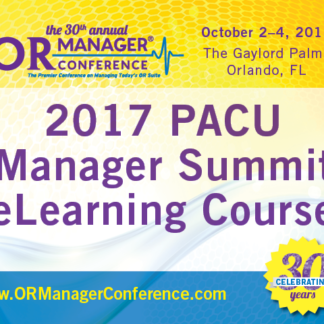Description
This package includes all business and finance sessions from the 2022 OR Manager Conference. Earn 6 contact hours upon completion of a post-test.
Presentations include:
- Preparing for OR Renovations – New Technology, Sustained Volumes, Staying on Budget
- Implementing Process Change to Find the Real Patient Safety Indicator Solutions
- Using a Balanced Scorecard to Decrease Intraoperative Costs by Increasing Awareness
- Transitioning Surgical Outpatients to the Ambulatory Environment
- Foundational Elements for Establishing Operational Excellence in Robotics
- Adaptive Clinical Management – A New Paradigm to Improve Efficiency, Effectiveness and Equity
Learn more about the sessions:
Preparing for OR Renovations – New Technology, Sustained Volumes, Staying on Budget
Incorporating new codes and technology in OR renovations while working with multidisciplinary teams can be quite a challenge, not to mention keeping volumes steady coming out of the era of pandemic-driven cancellations. This session will describe plans for OR renovations, including research into new products, technologies, design teams, and architects. Learn how this facility offset volumes while having two ORs down for a period of 12–14 weeks.
Implementing Process Change to Find the Real Patient Safety Indicator Solutions
One academic medical center’s (AMC) foundational plan and key steps to address Agency for Healthcare Research and Quality (AHRQ) Patient Safety Indicators (PSI 90), reduce clinical documentation variation, and effectively target adverse events and in-hospital complications. This session will discuss strategic team building, clinical and coding differences, and documentation improvements. Collaborative teamwork resulted in decreased observed/expected metrics in the Clinical Data Base (CDB) for each of the focused PSI 90 categories: PSI 9 Perioperative Hemorrhage or Hematoma Rate, PSI 11 Postoperative Respiratory Failure Rate, and PSI 13 Postoperative Sepsis Rate.
The AMC administration purposefully selected AHRQ Patient Safety Indicators (PSI 90) as an area for focused improvement in 2020, with emphasis on reliability of processes and service line optimization to reduce variation in clinical documentation.
A management guidance team (MGT) was developed. The MGT selected the above PSI 90 categories due to higher observed/expected rates in each category. Additionally, each of these PSIs effect both the quality and accountability scorecard and the Centers for Medicare and Medicaid Services Hospital-Acquired Condition Reduction Program. Tactical teams consisting of surgeons, anesthesiologists, registered nurses, quality management coordinators, data analysts, clinical documentation integrity (CDI) and coding specialists, information technologists, and performance improvement specialists were formed for each PSI.
Using a Balanced Scorecard to Decrease Intraoperative Costs by Increasing Awareness
The Balanced Scorecard (BSC) aimed to increase awareness of surgical supply costs among surgeons performing single-level Transforaminal Lumbar Interbody Fusions (TLIF) to determine if there is a correlation between increased knowledge and decreased costs. Each participant received a tailored, biweekly report displaying their median surgical supply costs, the group average, and group best. The report included a list of five items that were the most significant contributors to surgical supply costs. An electronic dashboard exhibiting anonymous surgical supply costs data for all participants was included with the BSC report to reflect performance trends and allow peer comparison. Patient length of stay and 30-day readmission data were collected to evaluate project influence on patient outcomes.
Transitioning Surgical Outpatients to the Ambulatory Environment
Escalating costs in today’s perioperative environment are a significant concern, undermining the financial viability of many hospitals amid the COVID pandemic. Hospitals are facing extraordinary challenges effectively balancing the cost of clinical care, managing escalating medical supply costs, and addressing capacity issues with higher acuity and increased co-morbidities among patients than ever before. Creating a multifaceted approach to address these issues requires “all hands on deck” and with innovative and integrated solutions lead collectively by nurses, physicians, and hospital administrators. Effective cost management strategies in the perioperative environment require a strong foundation to ensure quality patient care outcomes remain at the forefront while effectively managing the cost of care.
Attend this session to learn methodologies to effectively transition elective outpatient procedures from a traditional inpatient OR environment to an ambulatory setting.
Foundational Elements for Establishing Operational Excellence in Robotics
By identifying key elements of your operational playbook, team structure, and program awareness, your program can be elevated to operational excellence. Through transparency, process building practices, and boots on the ground leadership, your program can grow and improve exponentially. Our dyad model will pave the way. Fostering relationships with our team members and providers using data has proven to be a turning point in our program. Creating a robust dashboard with “good data in, good data out” to share clinical and financial metrics improves engagement on multiple levels with your providers and staff members. Improvements in communication with a daily wrap sheet during surgery that gives actionable data to leadership, steering committee members, and the team as a whole is a best-in-class tool to move your program forward. These tools will assist in driving your efforts for lean process improvement including standardization and reductions in variability.
Adaptive Clinical Management – A New Paradigm to Improve Efficiency, Effectiveness and Equity
Adaptive Clinical Management (ACM) is a method to simultaneously learn about and improve a healthcare system. ACM is a structured, iterative process of robust decision-making driven by real-world data captured by electronic medical records (EMR). Barriers to implementation of ACM include not collecting the data, not analyzing the data, not giving leaders and decision makers at the frontline access to the data, and/or failing to use the insights to make decisions. This session will teach all attendees how to overcome these barriers and apply ACM to their units and systems. We will use case studies of hospitals that have used this approach to improve clinical effectiveness, operational efficiency, and equity in the perioperative environment.



